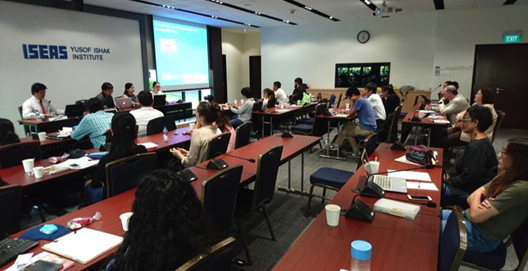
The 2016 Archaeological Field School at Prasat Thom, Koh Ker, Preah Vihear province, Cambodia.
(Credit: Dr. Ea Darith)
There were a total of 16 students who participated in the Field School from a variety of East Asian Summit countries including Australia; Cambodia; China; India; ; Indonesia; Malaysia; New Zealand; the Philippines; Singapore; Thailand; and Vietnam.
The itinerary featured interactive site visits and informal on-site lectures. Hands-on training sessions took participants and staff through 2000 years of complex socio-political and economic evolution. Topics also included urbanisation, exchange dynamics, cultural influence, and multi-directional agency among pan-Asian networks. The pivotal points of analytical foci and departure spanned the famed Khmer polities of Funan (1st-6th centuries CE), Chenla (7th-8th centuries CE), and Angkor (9th-14th centuries CE).
The main event included the coordinated archaeological and anthropological operations at multiple sites within the enigmatic 10th century Angkorian capital city of Koh Ker associated with the reign of Jayavarman IV. The field school was designed to complement ongoing efforts and build on the results of the 2015 field season. Participants lived on-site (in the forest) working with professional staff and local community members. They trained at several excavation locales to cover a diverse range of approaches, techniques and research questions. The results will provide valuable contributions to science, archaeology and history.
The final Field School leg in Singapore provided an important comparative component, added training opportunities, facilitated library access and allowed participants to finalise and present team projects. The Field School was funded by the Ministry of Foreign Affairs, Singapore. Primary institutions included ISEAS, APSARA Authority, and the National Authority for Preah Vihear. Supporting partners included the Ministry of Culture and Fine Arts, Cambodia; the Royal University of Fine Arts, Cambodia; The Royal Academy of Cambodia; the National Museum of Cambodia; the Hungarian Southeast Asian Research Institute; Ecole Française d’Extreme-Orient; and an extensive list of several other organisations and independent researchers who provided invaluable input, advice, opportunities and support.
2016 Field School Administrative History
2016 Archaeological Field School Announcement E-flyer (PDF, 450kb)
2016 Archaeological Field School Booklet (PDF, 2.42MB)
2016 Archaeological Field School Application Form (.doc, 211kb) (due 22 July 2016 +8GMT)
2016 Archaeological Field School Frequently Asked Questions (PDF, 333kb – updated 29 April 2016)
Image Gallery

Learning about traditional pottery making at a Kampong Chhnang potting village, led by Mr. Tep Sokha. (Credit: D. Kyle Latinis)

Drawing class at Prasat Damrei led by Aaron Kao (NSC). (Credit: D. Kyle Latinis)

Conservation and restoration workshop with APSARA National Authority at 9th century Bakong Temple – using traditional bricks, mortar, sandstone, and construction technology. (Credit: D. Kyle Latinis)

Mapping exercise with Michael Ng and Aaron Kao (NSC) at Prasat Andong Kuk. (Credit: D. Kyle Latinis)

Practicing profile drawings at the KK2 Habitation/Household Site. (Credit: D. Kyle Latinis)

Field school participants had the opportunity to visit and learn from the National Museum of Cambodia staff in Phnom Penh. (Credit: D. Kyle Latinis)

Field school participants visited Preah Vihear temple, guided by Preah Vihear authority staff. (Credit: D. Kyle Latinis)

The field school activities culminated in presentations at the ISEAS – Yusof Ishak Institute, Singapore. (Credit: D. Kyle Latinis)


